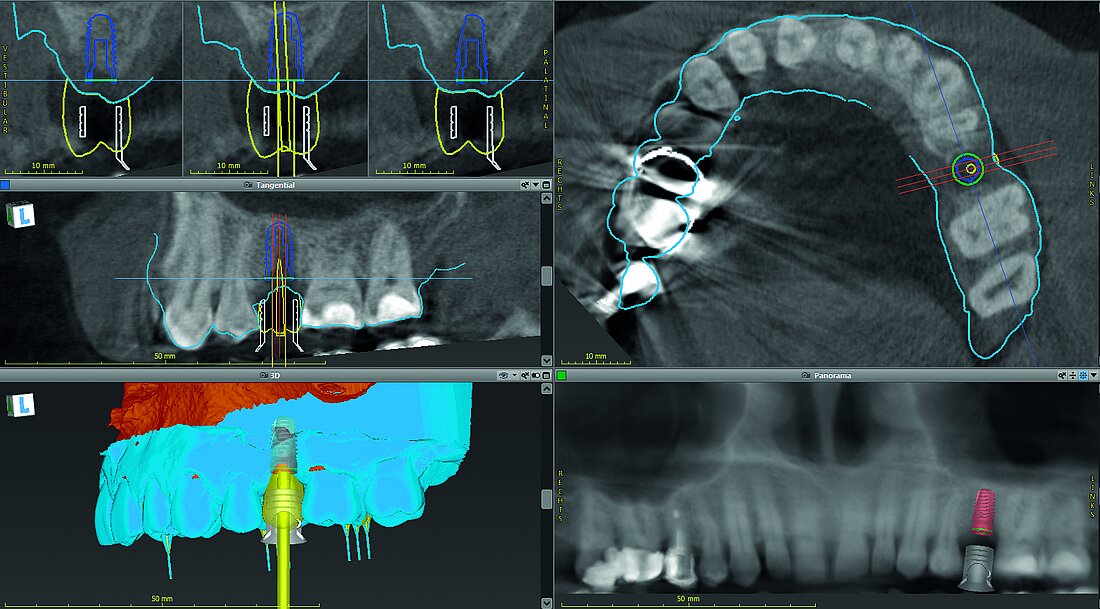Backward planning for the treatment with dental implants
The well-being of patients is the focus of every type of dental care. Well-being does not only refer to the function, but also to the aesthetics. Digitalization in dental technology opens up a number of possibilities with innovative processes and new technologies - also in the area of dental implants. Backward planning is one of these innovative methods, which opens up new possibilities to help patients achieve this well-being.
Imaging procedures enable implant prosthetics with backward planning
Three-dimensional X-rays (DVT), together with intraoral or model scans, provide a general overview of the patient's mouth and bone situation. This information can be used to carry out computer-assisted three-dimensional implant planning. The optimal length, angulation, alignment, drilling depth and number of implants are determined in order to achieve the ideal result for the individual patient situation.
When backward planning is recommended for implant restorations
The loss of teeth is usually accompanied by a loss of soft tissue and bone substance. These symptoms occur in many cases after several years of edentulism. In the conventional approach to treatment with implants, the implant is placed first and the denture (abutment and implant crown) is manufactured later on this basis. The implant position and angle often do not correspond to the ideal position in the jawbone. This makes it difficult to produce functional and aesthetic dentures.
In backward planning, on the other hand, the optimal dentures are planned backwards – according to the name. Measures for soft tissue and bone structure are also taken into account in the fully guided implant planning.
Since we start with the denture, this determines the position of the implants. The dentures, which are optimal in terms of function and aesthetics, are the first to be designed and serve as an immediate restoration for patients. With the help of this temporary crown made of plastic, patients can test the function, phonetics and aesthetics of the denture before using the definitive restoration.
It is therefore advisable to use backward planning, especially in complicated situations and when patients have high aesthetic demands.
Working basis for backward planning
- DICOM data from the DVT
- STL data of the intraoral scan
- Virtual tooth set-up
In order for the DVT data to be used, the following must be observed:
The difference between the gingiva and the cheek can hardly be seen on the DVT images. When the soft tissue is in contact with the alveolar ridge, a cotton roll should be inserted to expose the vestibule.
In addition, the tongue must not touch the palate during the DVT recording. Otherwise the tongue cannot be distinguished from the palate on the recording.
By many DVT recordings, the contrasts are not clear enough, making it difficult to assign the STL data.
CONCLUSION
At first glance, backward planning seems more expensive and time-consuming than the conventional way of dealing with implants. Due to the precision, however, the error rate is much lower and subsequent adjustments or new productions are only rarely necessary. The possibility of creating a digital customized drilling template based on the three-dimensional intelligent implant planning also minimizes the risk for the patient of the surgical intervention.
Guided implantation offers patients predictable time and cost planning. At the same time, this technology helps patients to have a natural chewing sensation and prevents tension and improper strain - for the best possible well-being.
The prerequisite for optimal success is close and trusting cooperation between the treating physicians and dental technicians as well as the inclusion of the patient in every step of the treatment.
Do you have questions about backward planning with CADdent? Talk to us, our experts will be happy to advise you!
